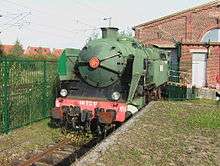Nord 4.1201 to 4.1272
| Nord 4.1201 – 4.1272 SNCF 2-141.TC | |||||||||||||||||||||||||||||||||||||
|---|---|---|---|---|---|---|---|---|---|---|---|---|---|---|---|---|---|---|---|---|---|---|---|---|---|---|---|---|---|---|---|---|---|---|---|---|---|
|
SNCF 2-141.TC.27 at Paris Gare du Nord, late August 1970 | |||||||||||||||||||||||||||||||||||||
| |||||||||||||||||||||||||||||||||||||
| |||||||||||||||||||||||||||||||||||||
| |||||||||||||||||||||||||||||||||||||
| |||||||||||||||||||||||||||||||||||||
Nord 4.1201 to 4.1272 was a class of French Mikado tank locomotives built for suburban service on the Chemin de fer du Nord's lines north of Paris.
They were designed by Marc de Caso, an engineer working in the company's engineering design office. They were equipped with the same boiler as the Nord's "Superpacifics" (3.1251 to 3.1290) They also had "Cossart" type rotary cam actuated valve gear.
The series were renumbered 2-141.TC.1 to 2-141.TC.72 by SNCF after its creation in 1938; the class was still in service until 12 December 1970, when the use of steam traction on the Nord commuter network was ended.
Construction history
The 72 locomotives were built from 1932 until 1935 by seven manufacturers, including the railway's own workshops at Hellemmes, Lille
| Year | Qty | Manufacturer | Serial No. | Nord No. | SNCF No. | Notes |
|---|---|---|---|---|---|---|
| 1932–33 | 5 | Hellemmes | — | 4.1201 – 4.1205 | 2-141.TC.1 to 2-141.TC.5 | |
| 1933–34 | 10 | SACM | 7688–7697 | 4.1206 – 4.1215 | 2-141.TC.6 to 2-141.TC.15 | |
| 1934 | 10 | ANF | 402–411 | 4.1216 – 4.1225 | 2-141.TC.16 to 2-141.TC.25 | |
| 1933–34 | 10 | SFB | 2679–2688 | 4.1226 – 4.1235 | 2-141.TC.26 to 2-141.TC.35 | |
| 1934–35 | 8 | ANF | 412–419 | 4.1236 – 4.1243 | 2-141.TC.36 to 2-141.TC.43 | |
| 1934 | 8 | SFB | 2689–2696 | 4.1244 – 4.1251 | 2-141.TC.44 to 2-141.TC.51 | |
| 1934 | 9 | Schneider | 4638–4646 | 4.1252 – 4.1260 | 2-141.TC.52 to 2-141.TC.60 | |
| 1934 | 6 | Fives-Lille | 4849–4854 | 4.1261 – 4.1266 | 2-141.TC.61 to 2-141.TC.66 | |
| 1934–35 | 6 | SFCM | 4254–4259 | 4.1267 – 4.1272 | 2-141.TC.67 to 2-141.TC.72 | |
From 1936, as an economy measure, the boiler pressure was reduced from 1.8 to 1.6 megapascals (260 to 230 lbf/in2), and the cylinder bore was reduced from 640 to 585 millimetres (25.20 to 23.03 in). This reduced the tractive effort from 266.37 to 197.38 kilonewtons (59,880 to 44,370 lbf).
Service history
In 1935, the 4.1200s essentially provide commuter services at the head of push-pull trains composed of five to nine cars, up to 420 tons gross. They are assigned in part to depots of Joncherolles, Mitry, Beaumont ... They are found between Paris on the one hand and Ermont, Creil and Pontoise on the other. In addition to the commuter traffic, 4.1200's also take charge of the freight service between Persian-Beaumont and Luzarches with reversal at Montsoult.
The beginning of the end began in 1969 and the last two trains to have been powered by 2-141.TC ran on December 12, 1970 with train 1731 between Paris-Nord and Valmondois via Ermont-Eaubonne (with 2-141.TC.64) and train 1748 between Persian-Beaumont and Paris-Nord via Valmondois and Ermont-Eaubonne (with 2-141.TC.54)[2]
Preservation

One locomotive has been preserved: 4.1251 / 2-141.TC.51 (SFB 2696 of 1934). This locomotive had been exhibited at the Brussels International Exposition, in 1935. It has been preserved by AAATV of Lille, and stored at Ascq.
Models
The 4.1200s / 2-141.TCs have been reproduced in HO scale by:
- RMA (French firm), brass injected model, released in 1987, 20 years after being announced
- Keyser (English craftsman), as a white metal kit
- Metropolitan (or Metrop) (high-end Swiss), brass model
- Fulgurex (high-end Swiss), very fine brass model.
References
- ↑ Davies 1997, pp. 131–133.
- ↑ Prévot 2013.
- Davies, John (January 1997). Chemins de fer du Nord Locomotive List 1842–1938. Sunnybank, Queensland: Dr. John Davies. ISBN 0-646-30938-2.
- Prévot, Aurélien (October 2013). "Les 2-141 TC : Portrait du Rail". Ferrovissime. Auray: LR Presse (64).
See also
| Wikimedia Commons has media related to Nord 4.1201 – 4.1272 → SNCF 2-141.TC. |
